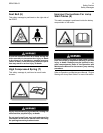
SEBU7858-03 19
Safety Section
General Hazard Information
Obey all local r
egulations for the disposal of liquids.
Use all cleaning solutions with care. Report all
necessary rep
airs.
Do not allow unauthorized personnel on the
equipment.
Unless you are instructed otherwise, perform
maintenanc
e with the equipment in the servicing
position. Refer to Operation and Maintenance Manual
for the procedure for placing the equipment in the
servicing p
osition.
When you perform maintenance above ground level
use approp
riate devices such as ladders or man lift
machines. If equipped, use the machine anchorage
points and use approved fall arrest harnesses and
lanyards.
Pressuri
zed Air an d Water
Pressurized air and/or water can cause debris
and/or ho
t water to be blown out. This could result in
personal injury.
When pre
ssurized air and/or pressurized water is
used for cleaning, wear protective clothing, protective
shoes, and eye protection. Eye protection includes
goggles
or a protective face shield.
The maximum air pressure for cleaning purposes
must be
reduced to 205 kPa (30 psi) when the
nozzle is deadheaded and the nozzle is used with
an effective chip d eflector and personal protective
equip
ment. The maximum water pressure for
cleaning purposes must be below 275 kPa (40 psi).
Tr apped Pressure
Press
ure can be trapped in a hydraulic system.
Releasing trapped pressure can cause sudden
machine movement or attachment movement. Use
caut
ion if you disconnect hydraulic lines or fittings.
High pressure oil that is released can cause a hose to
whip. High pressure oil that is released can cause oil
to sp
ray. Fluid p enetration can cause serious injury
and possible death.
Fluid Penetration
Pre
ssure can be trapped in the hydraulic circuit long
after the engine has been stopped. The pressure can
cause hydraulic fluid or items such as pipe plugs to
es
cape rapidly if the pressure is not relieved correctly.
Do not remove an
y hydraulic components or parts
until pressure has been relieved or personal injury
may occur. Do not disassemble any hydraulic
components or
parts until pressure has been relieved
or personal injury may occur. Refer to the Service
Manual for any procedures that are required to
relieve the h
ydraulic pressure.
g00687600
Illustration 20
Always use a board or cardboard when you check
for a leak. Leaking fluid that is under pressure can
penetrate body tissue. Fluid penetration can cause
serious injury and possible death. A pin hole leak can
cause severe injury. If fl uid is injected into your skin,
you must get treatment immediately. Seek treatment
from a doctor that is familiar with this type of injury.
Containing Fluid Spillage
Care must be taken in order to ensure that fluids
are contained during performance of inspection,
maintenance, testing, adjusting and repair of the
equipment. Prepare to collect the fluid with suitable
containers before opening any compartment or
disassembling any component that contains fluids.
Refer to Special Publication, NENG2500, “Caterpillar
Dealer Service Tool Catalog” for the following items:
•
Tools that are suitable for collecting fluids and
equipment that is suitable for collecting fluids
•
Tools that are suitable for containing fluids and
equipment that is suitable for containing fluids
Obey all local regulations for the disposal of liquids.


















